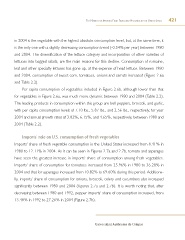Page 421 - FRUTAS DEL TRÓPICO
P. 421
421
the maRket foR impoRted fResh fRuits and vegetables in the united states
in 2004 is the vegetable with the highest absolute consumption level, but, at the same time, it
is the only one with a slightly decreasing consumption trend (-0.54% per year) between 1980
and 2004. The diversification of the lettuce category and incorporation of other varieties of
lettuces into bagged salads, are the main reasons for this decline. Consumption of romaine,
leaf and other specialty lettuces has gone up, at the expense of head lettuce. Between 1980
and 2004, consumption of sweet corn, tomatoes, onions and carrots increased (Figure 2.6a
and Table 2.2).
Per capita consumption of vegetables included in Figure 2.6b, although lower than that
for vegetables in Figure 2.6a, was much more dynamic between 1980 and 2004 (Table 2.2).
The leading products in consumption within this group are bell peppers, broccoli, and garlic,
with per capita consumption levels of 7.10 lbs., 5.87 lbs., and 2.56 lbs., respectively, for year
2004 and annual growth rates of 3.82%, 6.15%, and 4.65%, respectively, between 1980 and
2004 (Table 2.2).
Imports’ role on U.S. consumption of fresh vegetables
Imports’ share of fresh vegetable consumption in the United States increased from 8.41% in
1980 to 12.11% in 2004. As it can be seen in Figures 2.7a and 2.7b, tomato and asparagus
have seen the greatest increase in imports’ share of consumption among fresh vegetables.
Imports’ share of consumption for tomatoes increased from 25.96% in 1980 to 36.28% in
2004 and that for asparagus increased from 10.82% to 69.60% during this period. Additiona-
lly, imports’ share of consumption for onions, broccoli, celery and cucumbers also increased
significantly between 1980 and 2004 (Figures 2.7a and 2.7b). It is worth noting that, after
decreasing between 1980 and 1992, pepper imports’ share of consumption increased, from
13.48% in 1992 to 27.26% in 2004 (Figure 2.7b).
Universidad Autónoma de Chiapas

